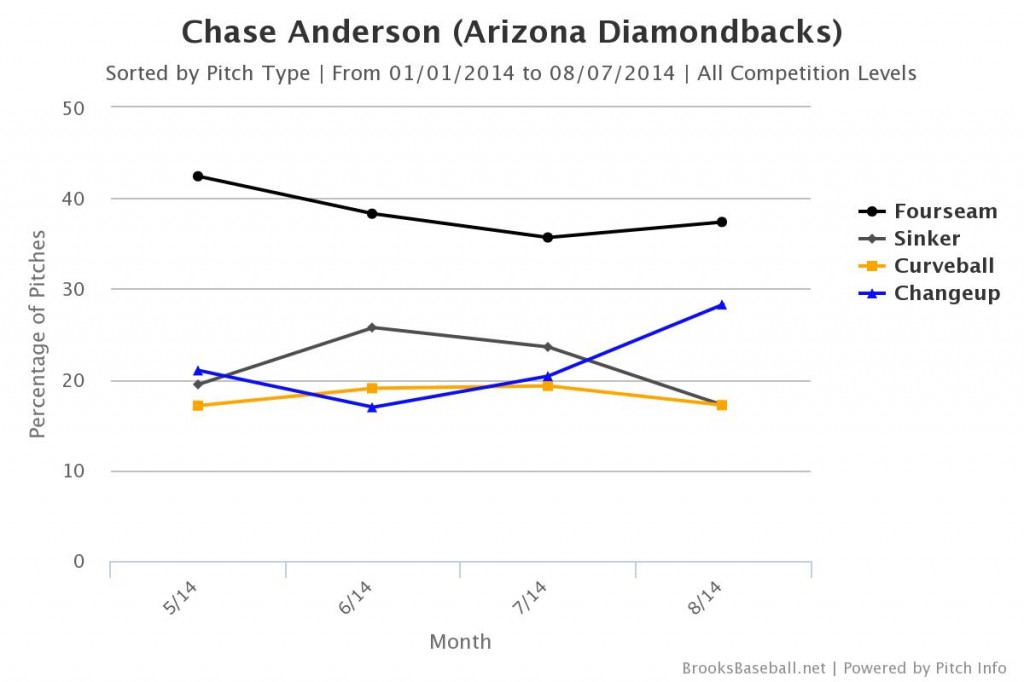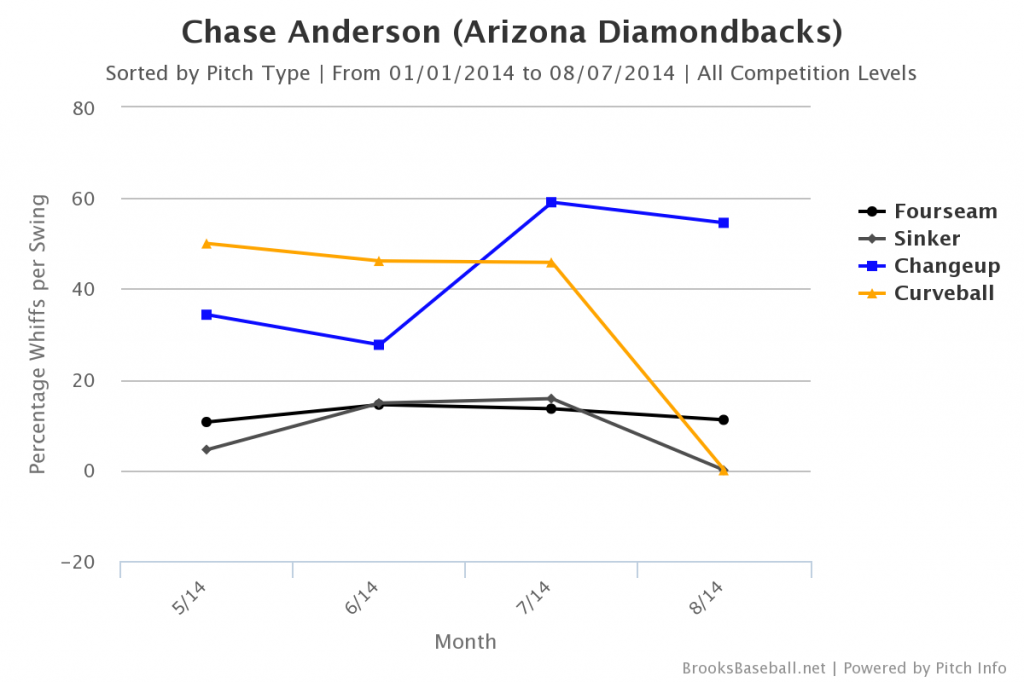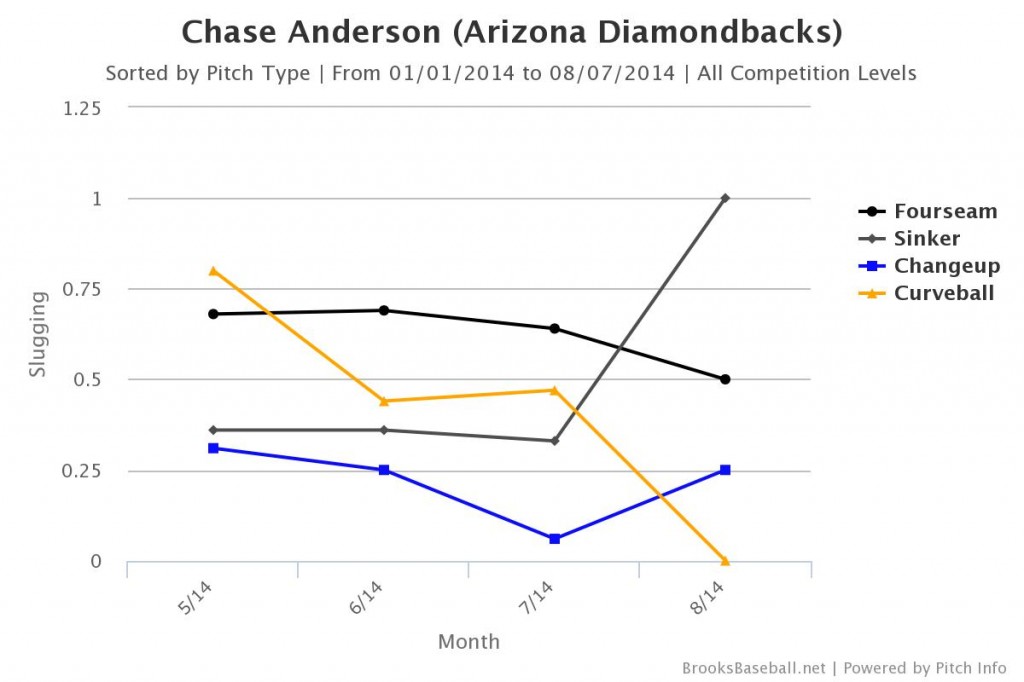Chase Anderson Proves that Change Can Be Good, But Changeups Can Be Better
Things didn’t go so well at the outset of the season, and with playoff chances somehow disappearing in the middle of April before their eyes, the D-backs quickly replaced the struggling Trevor Cahill and Randall Delgado in the rotation. On came the parade of replacements, with the club clearly hoping that something would stick. When Mike Bolsinger had seemingly proven that he wasn’t a solution, the D-backs dug deeper.*
How deep? Deep enough to pluck a 26-year-old pitcher who had struggled so much at Triple-A Reno in 2013 that he was tried as a reliever there, and then demoted to Double-A Mobile before the start of 2014. Reno and the Pacific Coast League are tough, but not tougher than the majors. And make no mistake — this was a leap. Yes, Trevor Cahill was struggling in this, his sixth major league season.
Chase Anderson is older than Cahill. But despite the 2013 fiasco and being ancient by Double-A standards, Anderson must have been pretty enticing in early May; he had a 0.69 ERA through six starts, showing impeccable control (1.38 BB/9), a solid strikeout rate (8.77 K/9), and generally weak contact with only one home run allowed.
So far this season, Anderson’s MLB peripherals are almost identical to those of his terrible 2013, and the fact that he’s had much better results is not necessarily his fault. On some level, though, results speak for themselves. And what Anderson has been so far this season is, quite possibly, the best pitcher on a terrible staff. Here’s what I mean on 2013 (AAA) versus 2014 (MLB):
A big difference from Double-A is the walk rate; not only did Anderson have a 1.38 BB/9 in his short stint this April and May, but he was quite a bit sharper in 2012 at Mobile, too (2.16 BB/9).
The numbers make it look, though, like the Anderson we’re seeing might be a mirage. A 4.47 FIP is not particularly good; among all D-backs pitchers with at least 50 innings this year, Anderson’s FIP is 9th out of 9, and it’s not that close.
His ERA, though (3.19), is 2nd-best out of that 9, behind only Brad Ziegler (3.16), whose ERA gets a nice little bump because he gets used mid-inning fairly frequently. So what the hell is going on with Anderson, and who the hell is he?
Chase Anderson: Mirage?
We probably need a nickname for Chase Anderson’s before-inning chin ups. ChaseUps? Chindersons?
— Ryan P. Morrison (@InsidetheZona) June 4, 2014
We have a handy little checklist for figuring out when a player is getting lucky. The difference between Anderson’s FIP and his ERA is what caused us to ask this question in the first place: that’s one pretty big sign, because it means that, typically, a pitcher with Anderson’s walk, strikeout and home run rates fare quite a bit worse than he’s done so far.
League-average BABIP is just a hair under .300 (.298), and Anderson has enjoyed a .286 BABIP so far. That could be a little lucky, but it’s nothing to raise alarms about. But Anderson has been lucky: he’s left 82.1% of runners on base, which is ridiculous. Only superlative strikeout pitchers can outperform the league LOB% consistently, and that’s just not who he is. The league-average 73% left on base percentage is what we should expect for Anderson moving forward. And he’s allowed 97 runners so far in MLB — the LOB% luck cost opposing teams about 9 runs, and 9 runs would raise Anderson’s ERA from 3.19 to 4.30. That 4.47 FIP is all of a sudden looking much more accurate.
But things aren’t as bad as all that. Maybe the best estimate of what Anderson’s ERA should be comes from SIERA, which has him at 3.91. SIERA doesn’t just compute component stats like FIP; it takes into account that not everything is linear. For instance, walking 4 men per 9 innings is not twice as bad as walking 2; it’s much worse than that. With SIERA, we strip out the LOB% but keep things that FIP doesn’t quite capture, like the fact that Anderson’s BB/9 is low enough that it’s not really much more concerning than if it were even lower. You can read more about SIERA at FanGraphs, but it’s kind of the pitching equivalent of wRC+, which is kind of a “house stat” here at Inside the ‘Zona. Embrace it!
So is Anderson’s success a mirage? It’s exaggerated, but it’s not fake. A 3.91 ERA pitcher would still be a pretty good pitcher, especially for a staff as thin as that of the D-backs.
Lessons from Anderson’s Repertoire
Back in June, RG examined Chase Anderson’s repertoire, explaining how Anderson had had success in some ways, but not in others, and how he might do better by throwing more sinkers. I won’t re-tread that ground, but a new trend has emerged that I wanted to share. Before that, briefly: Chase Anderson is a true four-pitch pitcher. One can’t throw each of four pitches more than 25% of the time, but his least-frequently-thrown pitch, the curveball, has still been thrown 18.6% of the time so far this year. Anderson appears to be keeping batters guessing, and that may be a big part of his success. More on that in a minute, but first, a look at Anderson’s pitch mix:
When we last checked in on Anderson, RG made a great pitch to Anderson to start using his sinker more. RG’s advice still holds; the sinker is still killing it, and going sinker instead of fourseam more often could be a key to unlocking a new gear for Anderson. Anderson did make a small change, but a different one. Sorry to dump two more charts on you in quick succession, but take a look at these; first is whiff rate on each of the four pitches, and the other is slugging against. A strong, new trend has emerged more recently.
So that was whiff rate. This is slugging against. Focus on July:
In July, slightly more sinkers, slightly better results. As RG noted, part of that the sinker’s success against right-handed batters, which is something Anderson wasn’t doing particularly well at that point.
Anderson still throws his fourseam fastball more than any other pitch. He works off of that. And it’s terrible.
FanGraphs has “Pitch Values” and “PITCHf/x Values” for every pitcher’s pitches. To better compare every kind of measurable baseball skill, we like communicating statistics like this in terms of runs or wins. And both of these statistics are communicated in runs units. Both statistics agree: Anderson’s fastball, in just 73.1 innings of throwing it, is more than ten runs below average. Turned into a “per 100 pitches” stat, Anderson’s fastball is worth nearly 2 runs less than the average fastball (-1.86 wFA/C). That is incredible; it means that if Anderson were to throw a 100-pitch start and throw only fastballs, based on the past success he’s “enjoyed” with the fastball, he’d give up 2 runs more than the average pitcher. Since the average pitcher gives up more than 4.5 runs per 9 innings (that’s what league average ERA is, roughly), we can guess that if Anderson threw a 100-pitch fastball start, he’d give up, on average, about 6 runs. No MLB pitcher is that bad.
So far this year, batters have a .657 slugging percentage against Anderson’s fourseam fastball. This year, Paul Goldschmidt has a .542 slugging percentage, and there is no qualified hitter with a slugging percentage better than Jose Abreu‘s .616. Troy Tulowitzki is next at .603. If an average hitter were to tee off only against Anderson’s fastball, he’d be doing more damage than any other batter on the planet.
Of course, no pitcher throws only their worst pitch — and you can probably see now why Anderson is a 4-pitch pitcher. And the good news is that Anderson has a touch of greatness about him.
In the first two charts above, you can see that Anderson has started to throw his changeup more (first chart), back up over 20% of the time. He also had extraordinary success with it in July, with hitters who swung at the changeup completely missing it nearly 60% of the time (second chart). This entire year, hitters have slugged just .212 against the changeup (third chart), which is like saying that hitters only get one base per 5 AB. Remember those pitch value stats from a moment ago? PITCHf/x Pitch Values has Anderson’s changeup worth more than 8 runs above average, which is stunning in that Anderson has only thrown it 239 times. The per-100 stat has the changeup worth 3.5 runs better than the average changeup. That’s like saying that if Anderson threw only changeups in a 100-pitch start, he’d give up, on average, only about half a run.
Against Anderson’s fastball, every hitter is a god. Against Anderson’s changeup, every hitter hits like Bronson Arroyo. These two things are most assuredly related, as you’ve probably also guessed. And in reality, if Anderson threw only fastballs, he’d be punished even worse than 6 runs per 100-pitch start, because hitters would sit on it; that stat already includes whatever value Anderson has garnered from keeping hitters guessing. Conversely, if Anderson threw only changeups, there’s a pretty big chance he’d get punished on those, too. It’s really encouraging that Anderson has slightly ramped up his changeup usage, and that its success didn’t diminish. It would not be ridiculous if, in this lost season, the D-backs experimented with Anderson throwing it even more.
Put it this way: Anderson’s no-movement, 91-mph fastball is a very spicy meatball for opposing batters. They could eat those meatballs for days. But Anderson’s changeup is so good that it also looks like it’s slathered in marinara sauce.
Of 92 qualified pitchers this season, only 7 have a changeup runs-per-100 of better than 2. R.A. Dickey leads the pack at 3.28, Felix Hernandez is second at 2.83. If Anderson were qualified, he’d slot in first with his 3.50, and third place would be miles away. As we saw before, Anderson is probably not a great pitcher, but more of a fairly good one, a 3.90 ERA type. But Anderson does have a touch of greatness about him, and that can be great to watch, too.
11 Responses to Chase Anderson Proves that Change Can Be Good, But Changeups Can Be Better
Leave a Reply Cancel reply
Recent Posts
@ryanpmorrison
 Best part of Peralta’s 108 mph fliner over the fence, IMHO: that he got that much leverage despite scooping it out… https://t.co/ivBrl76adF, Apr 08
Best part of Peralta’s 108 mph fliner over the fence, IMHO: that he got that much leverage despite scooping it out… https://t.co/ivBrl76adF, Apr 08 RT @OutfieldGrass24: If you're bored of watching Patrick Corbin get dudes out, you can check out my latest for @TheAthleticAZ. https://t.co/k1DymgY7zO, Apr 04
RT @OutfieldGrass24: If you're bored of watching Patrick Corbin get dudes out, you can check out my latest for @TheAthleticAZ. https://t.co/k1DymgY7zO, Apr 04 Of course, they may have overtaken the league lead for outs on the bases just now, also...
But in 2017, Arizona ha… https://t.co/38MBrr2D4b, Apr 04
Of course, they may have overtaken the league lead for outs on the bases just now, also...
But in 2017, Arizona ha… https://t.co/38MBrr2D4b, Apr 04 Prior to the games today, there had only been 5 steals of 3rd this season (and no CS) in the National League. The… https://t.co/gVVL84vPQ5, Apr 04
Prior to the games today, there had only been 5 steals of 3rd this season (and no CS) in the National League. The… https://t.co/gVVL84vPQ5, Apr 04 RT @OutfieldGrass24: Patrick Corbin has a WPA of .318 and it's only the fifth inning., Apr 04
RT @OutfieldGrass24: Patrick Corbin has a WPA of .318 and it's only the fifth inning., Apr 04
Powered by: Web Designers@outfieldgrass24
 RT @ZHBuchanan: Our @Ken_Rosenthal spoke to Ken Kendrick about trading Paul Goldschmidt.
https://t.co/O5fHRlyBxD, 5 hours ago
RT @ZHBuchanan: Our @Ken_Rosenthal spoke to Ken Kendrick about trading Paul Goldschmidt.
https://t.co/O5fHRlyBxD, 5 hours ago RT @CardsNation247: We have a good show lined up for tonight. Leading off is our friend of the show @buffa82 followed by Jeff Wiser… https://t.co/eltZC0uvyg, 5 hours ago
RT @CardsNation247: We have a good show lined up for tonight. Leading off is our friend of the show @buffa82 followed by Jeff Wiser… https://t.co/eltZC0uvyg, 5 hours ago RT @juanctoribio: To piggyback off the @ZHBuchanan and @OutfieldGrass24 that the #Rays were involved in the Paul Goldschmidt sweepsta… https://t.co/spg9x7X1L5, 6 hours ago
RT @juanctoribio: To piggyback off the @ZHBuchanan and @OutfieldGrass24 that the #Rays were involved in the Paul Goldschmidt sweepsta… https://t.co/spg9x7X1L5, 6 hours ago RT @OJCarrascoTwo: Read this from the world famous, @OutfieldGrass24 https://t.co/cHUie1I5Le, 6 hours ago
RT @OJCarrascoTwo: Read this from the world famous, @OutfieldGrass24 https://t.co/cHUie1I5Le, 6 hours ago RT @TheAthleticAZ: A great source, our @ZHBuchanan and @OutfieldGrass24, for #DBacks info - and MLB Network agrees. https://t.co/QUNql4ol79, 6 hours ago
RT @TheAthleticAZ: A great source, our @ZHBuchanan and @OutfieldGrass24, for #DBacks info - and MLB Network agrees. https://t.co/QUNql4ol79, 6 hours ago
Powered by: Web Designers









I like Anderson’s stuff a lot, and the way he works through a lineup is indicative of a crafty veteran already. Next season he should be the front runner for the fifth spot in the rotation.
How do you predict our rotation looking next year? If Bradley gets the call, and he should, I see it being solid but not dominant. If that’s the case, do we go after a TOR arm in free agency? Or do we wait another two years for Shipley?
My guess is that the D-backs will make a hard run at Scherzer or Shields. Don’t know it’ll happen at any kind of reasonable price or if it’ll happen at all, especially with the Yankees hurting in the rotation and the Red Sox having freed up Lester money, but yeah.
Bradley is clearly very likely to happen, although like any other prospect he might just never be who he’s supposed to be, even enough to justify a promotion. So:
1. Corbin
2. ?
3. ?
4. ?
5. Profit
Think you meant “Prophet.” No big deal.
What are your thoughts of LOB% being a sign of control under pressure. Not saying that is the case with Anderson, but at some point there is a correlation. How would you best try to achieve a true representation of control under pressure: low LOB% and high/low ?(other stat(s))?
The thing we do know about LOB% is that it doesn’t tend to vary much from the norm (72%) in the long term. It can fluctuate from time to time, and the Dbacks have a reasonably good infield defensively, but nothing that would suggest an 83% LOB% is sustainable. Even elite strikeout pitchers, guys who strand batters all on their own, rarely touch this level even for a brief moment. Anderson’s LOB% for his 26 AAA games last year was 58%. In 2012 his rate was 80% and in 2010 it was 66%. You can see the fluctuations, but nothing that would suggest that what we’re seeing is real. Anderson’s LOB% is 4th highest in baseball among all pitchers with 70 IP, and I don’t think anyone would suggest that it’s indicative of his true talent.
1. Cahill
1. Collmenter
2. Miley
3. Anderson
4. Hudson
5. Nuno
$100 says Nuno isn’t in the bigs next year – at least not in Sedonda Red. He was the dictionary definition of salary dump.
2004 was fun
[…] Chase Anderson Proves that Change Can Be Good, But Changeups Can Be Better […]
[…] still leaves some time to experiment. Two weeks ago, we covered just how dominating Anderson’s changeup has been. But as I mentioned in the post-Saber Seminar roundup on Monday, David Gassko had a very […]
[…] key to Anderson’s success has and will always be his changeup. It is crazy effective, and while he throws it at a higher frequency than most starters, there has been such a gap between […]